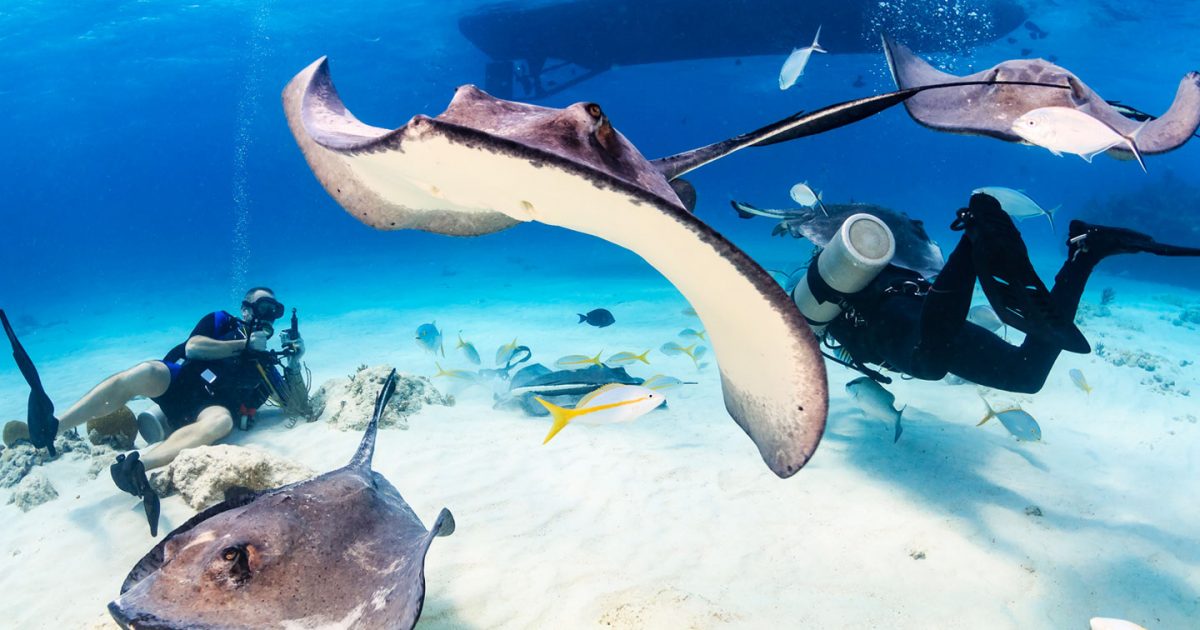
1. Stingray City
The world famous Stingray City is an absolute “must-do” for any visitor to Cayman and is often described as the experience of a lifetime. Stingray City is home to approximately 75 Southern Stingrays that you can touch and swim with. These wild, gentle and graceful creatures roam free in the North Sound, a 35 square mile area of ocean protected by the reef. Even the most seasoned traveler will be enchanted by these beautiful animals. Click this link for more information and recommended tours: Stingray City
2. Cayman Turtle Centre
Cayman’s largest land-based attraction, Cayman Turtle Centre: Island Wildlife Encounter hosts more than 500,000 visitors each year. See turtles new hatchlings (when in season) right up to turtles weighing more than 500lb. Then head to the touch tanks and wading pool for a more personal experience. This attraction also includes a lagoon with a waterslide, a Predator Reef for viewing reef and nurse sharks, a nature trail and more!
3. Pedro St. James
Built in 1780 by a wealthy Englishman named William Eden and at a time when Grand Cayman was little more than a fishing village, the history of Pedro’s Castle is by far one of the more impressive stories to be told in the Cayman Islands. The Castle is often termed the “The Birthplace of Democracy in the Cayman Islands”. It was the venue for not only the decision in 1931 to form the Cayman Island’s first elected parliament but also the announcement in 1835 that slavery had ended in the British Empire. Click this link for more details: Pedro St. James
4. Queen Elizabeth II Botanic Park
Opened by Queen Elizabeth II herself in 1994, in partnership with the National Trust, this is Cayman’s only botanical garden. The 65-acre park is dedicated to preserving local flora, fauna and wildlife. It is home to the Blue Iguana Recovery program, and is the only place in Grand Cayman where you will find these magnificent endangered creatures. Click this link to learn more: Queen Elizabeth II Botanic Park
5. Cayman Islands National Museum
The Island’s oldest surviving public structure. The Museum’s mission is to celebrate the unique natural and cultural history of the Cayman Islands.
6. Kittiwake
Sitting at a depth of 62ft in clear Caribbean waters, the Kittiwake is a former submarine rescue vessel that served in the US Navy. In 2011, she was scuttled off Seven Mile Beach to create a spectacular wreck dive that now attracts around 20,000 divers and snorkelers a year, plus abundance of marine life, including schools of tropical fish, sea turtles, eagle rays, the resident barracuda, groupers and more! Also discover the crew’s quarters, the recompression chamber, ammunition lockers and even the heads (bathrooms) – complete with mirrors.
7. National Gallery of the Cayman Islands
The National Gallery of the Cayman Islands houses the national art collection and attracts numerous international exhibitions throughout the year. It also offers an art library, sculpture garden, shop and café.
8. Cayman Motor Museum
The Cayman Motor Museum showcases 80 classic automobiles, providing a historical tour of motoring throughout the world. Also on display is a selection of motorcycles, power boats and historical exhibits. When you have finished viewing the collection you can relax and enjoy a drink in the authentic vintage diner on-site.
9. Crystal Caves
Enjoy an underground adventure into a fascinating world. Explore the Crystal Caves which were formed over millions of years and see stalactite and stalagmite crystal structures and other worldly formations. Pirates are reported to have used these caves as hideouts and legend has it that there are pirate treasures buried in some of these caves. Crystal Caves. Tours are approximately 1 ½ hours and take you through the surrounding tropical forest area and three spectacular caves. Crystal Caves.
10. The Mastic Trail
The Mastic Reserve protects the large area of untouched, old growth dry forest remaining on the island. It is significant as it represents some of the last remaining examples of the Caribbean’s dry, subtropical, semi deciduous dry forest, which have been the target of particularly intense deforestation throughout the West Indies. It area is home to a wide variety of animals and plants unique to the Cayman Islands, and also to large populations of trees which have vanished from more accessible places through logging in the eighteenth and nineteenth centuries. The National Trust runs informative and interesting guided tours so can you learn more about the historical significance of this area.

